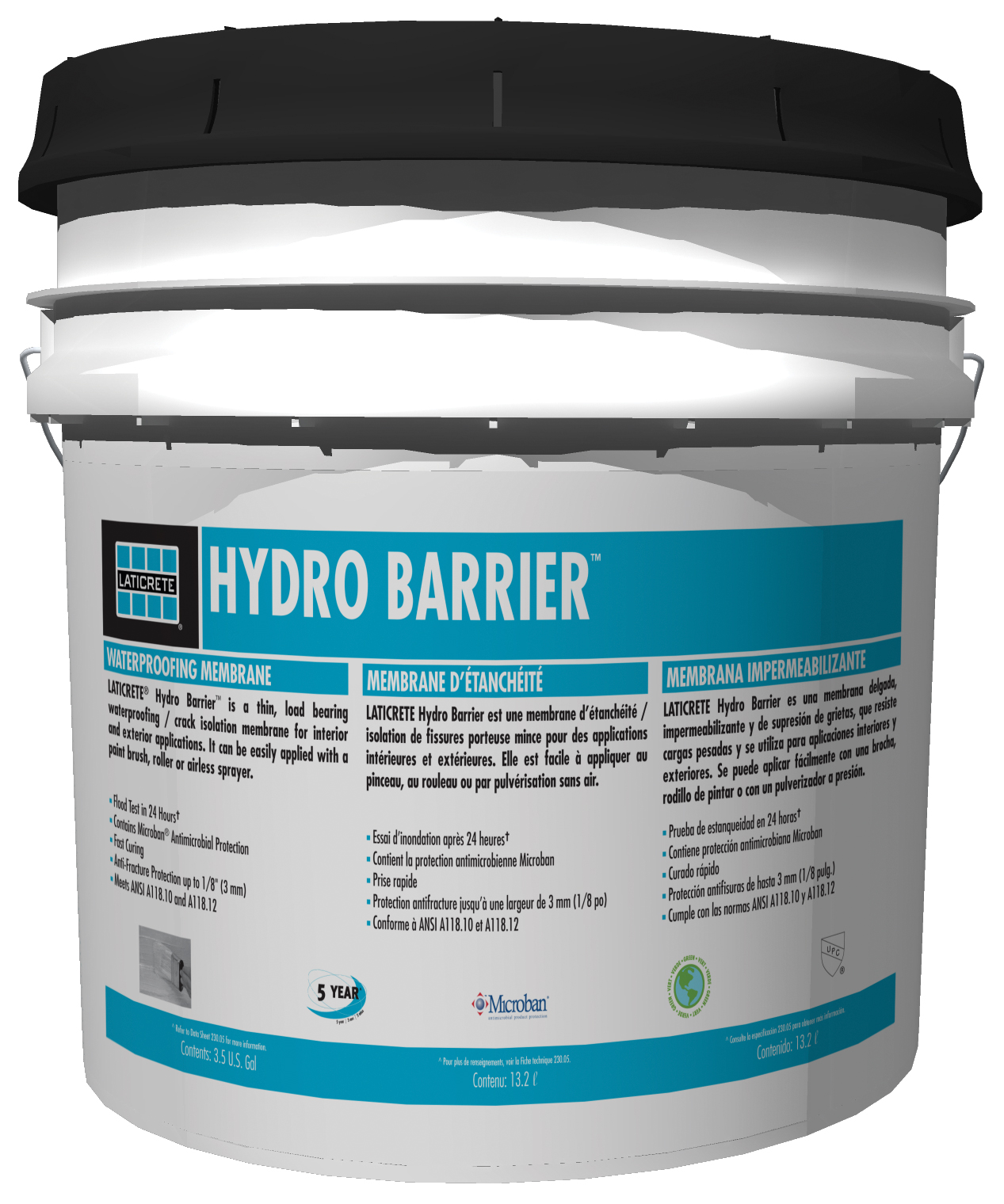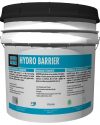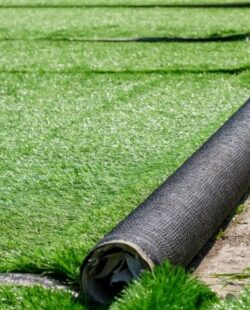No product in cart
Hydro Barrier
-
(0s)
- Add your review
PRODUCT DESCRIPTION LATICRETE Hydro Barrier is a thin, load bearing, self curing liquid rubber polymer which can be easily applied to form a flexible seamless waterproof/anti-fracture membrane. LATICRETE Hydro Barrier can be used on interior and exterior, horizontal or vertical surfaces and is approved by IAPMO for use as shower pan liner. PRODUCT […]
#Code Products:
Description
PRODUCT DESCRIPTION
LATICRETE Hydro Barrier is a thin, load bearing, self curing liquid rubber polymer which can be easily applied to form a flexible seamless waterproof/anti-fracture membrane. LATICRETE Hydro Barrier can be used on interior and exterior, horizontal or vertical surfaces and is approved by IAPMO for use as shower pan liner.
Uses
Interior and exterior.
Swimming pools, fountains and water features.
Shower pans, stalls and tub surrounds.
Industrial, commercial and residential bathrooms and laundries.
Spas and hot tubs.
Kitchens and food processing areas.
Terraces and balconies over unoccupied spaces.
Countertops and facades.
Steam rooms (when used in conjunction with a vapor barrier).
Advantages
Allows for flood testing in 24 hours.*
Thin; only 0.020–0.030″ (0.5–0.8 mm) thick when cured.
Changes in color from a light blue to darker blue when cured.
Anti-fracture protection of up to 1/8″ (3 mm) over shrinkage and other non-structural cracks.
“Extra Heavy Service” rating per TCNA performance levels (RE: ASTM C627 Robinson Floor Test).
Exceeds ANSI A118.10 and A118.12.
IAPMO approved containing Microban ® antimicrobial product protection.
Fast curing; allows foot traffic in 4–6 hours @ 70°F (21°C), 50% RH.
Lighter color for ease of inspection.
Safe—no solvents and non-flammable.
Install tile, brick and stone directly onto membrane.
*When cured 70°F (21°C) or higher at 50% RH lower temperature at higher RH will require long cure times.
Suitable Substrates
Concrete
Concrete & brick masonry
Cement mortar beds
Cement plaster
Gypsum wallboard*
Exterior glue plywood*
Ceramic tile & stone**
Cement terrazzo**
Cement backer board***
Poured Gypsum Underlayment †
* Interior applications only.
**If skim coated with a LATICRETE® Latex Thin-Set Mortar.
***Consult cement backer board manufacturer for specific installation recommendations and to verify acceptability for exterior use.
† Interior use only. Follow TCNA Guidelines/ Methods: F200, RH111, RH122, F180
Packaging
Full Unit: 3.5 gal (13.3 ℓ) pail liquid (48 full units/pallet)
Mini Unit: 4 x 1 gal (3.8 ℓ) pails of liquid packed in a carton (30 cartons/pallet)
LATICRETE Waterproofing/Anti-Fracture Fabric sold separately.
Item# S-09235-NF-19
Approximate Coverage
Full Unit: 175 ft2 (16.3 m2 )
Mini Unit: 50 ft 2 (4.6 m2)
Shelf Life
Factory sealed containers of this product are guaranteed to be of first quality for two (2) years* if stored at temperatures >32°F (0°C) and <110°F (43°C).
* High humidity will reduce the shelf life of bagged product.
Limitations
DO NOT bond to OSB, particle board, luan, Masonite ®or hardwood surfaces.
Adhesives/mastics, mortars and grouts for ceramic tile, pavers, brick and stone are not replacements for waterproofing membranes. When a waterproofing membrane is required, use LATICRETE Hydro Barrier.
Note: Surfaces must be structurally sound, stable and rigid enough to support ceramic/stone tile, thin brick and similar finishes. Substrate deflection under all live, dead and impact loads, including concentrated loads, must not exceed L/360 for thin bed ceramic tile/brick installations or L/480 for thin bed stone installations where L=span length.
Requires the use of LATICRETE® Waterproofing/Anti-Fracture Fabric in the coves and corners or any change of plane when used as waterproofing membrane.
When using LATICRETE Hydro Barrier fabric is not required when it is being used as a full field coating for crack isolation and is an option when chasing existing cracks
DO NOT use as a primary roofing membrane over occupied space.
DO NOT use over dynamic expansion joints, structural cracks or cracks with vertical differential movement (See LATICRETE Hydro Barrier™ Installation Instructions, DS 105.5, for complete instructions).
DO NOT use over cracks >1/8″ (3 mm) in width.
DO NOT use as a vapor barrier (especially in steam rooms).
DO NOT expose unprotected membrane to sun or weather for more than 30 days.
DO NOT expose to negative hydrostatic pressure, excessive vapor transmission, rubber solvents or ketones.
Must be covered with ceramic tile, stone, brick, concrete, screeds, terrazzo or other traffic-bearing finish. Use protection board for temporary cover.
Obtain approval by local building code authority before using product in shower pan applications.
DO NOT install directly over single layer wood floors, plywood tubs/showers/fountains or similar constructs.
Not for use beneath cement or other plaster finishes. Consult with plaster manufacturer for their recommendations when waterproofing membrane is required under plaster finishes.
Not for use under self-leveling underlayments or decorative wear surfaces.
Cautions
Consult MSDS for more safety information.
Allow membrane to cure fully (typically 24 hours @ 70°F (21°C) and 50% RH before flood testing); flood test prior to applying tile or stone.
Maximum amount of moisture in the concrete/mortar bed substrate should not exceed 5 lbs/1,ooo ft2 (283 µg/s • m2)per ASTM F-1869 or 75% relative humidity as measured with moisture probes.
During cold weather, protect finished work from traffic until fully cured.
For white and light-colored marbles, use a white LATICRETE Latex Portland Cement Thin Set Mortar.
For green and moisture sensitive marble, agglomerates and resin backed tile and stone use LATAPOXY®
300 Adhesive (refer to Data Sheet 633.0).
Allow wet mortars/ plasters (deck mud consistency) to cure for 72 hours at 70°F (21°C) prior to installing LATICRETE Hydro Barrier.
For temperatures between 45–69°F (7–21°C) allow 3 days prior to flood testing.
Protect from exposure to traffic or water until fully cured.
Working Properties
LATICRETE Hydro Barrier can be applied using a paint brush, roller, trowel or airless sprayer. All areas must have two coats to ensure waterproofing capabilities. When the second coat is applied the substrate will not show through LATICRETE Hydro Barrier if coated with 0.020–0.030″ (0.5–0.8 mm) of dried membrane. Color changes from a light blue to darker blue when fully cured.
5. INSTALLATION
Surface Preparation
Surface temperature must be 50–90°F (10–32°C) during application and for 24 hours after installation. All substrates must be structurally sound, clean and free of dirt, oil, grease, paint, laitance,efflorescence, concrete sealers or curing compounds. Make rough or uneven concrete smooth to a wood float or better finish with a LATICRETE underlayment. Do not level with gypsum or asphalt based products. Maximum deviation in plane must not exceed 1/4″ in 10 ft (6 mm in 3 m) with no more than 1/16″ in 1 ft (1.5 mm in 0.3 m) variation between high spots. Dampen hot, dry surfaces and sweep off excess water—installation may be made on a damp surface. New concrete slabs shall be damp cured and a minimum of 14 days old before application.
1. Installer must verify that deflection under all live, dead and impact loads of interior plywood floors does not exceed industry standards of L/360 for ceramic tile and brick or L/480 for stone installations where L=span length.
2. Minimum construction for interior plywood floors.
SUBFLOOR: 5/8″ (15 mm) thick exterior glue plywood, either plain with all sheet edges blocked or tongue and groove, over bridged joints spaced 16″ (400 mm) o.c. maximum; fasten plywood 6″ (150 mm) o.c. along sheet ends and 8″ (200 mm) o.c. along intermediate supports with 8d ring-shank, coated or hot dip galvanized nails (or screws); allow 1/8″ (3 mm) between sheet ends and 1/4″ (6 mm) between sheets edges; all sheet ends must be supported by a framing member; glue sheets to joints with construction adhesive.
UNDERLAYMENT: 5/8″ (15 mm) thick exterior glue plywood fastened 6″ (150 mm) o.c. along sheet ends and 8″ (200 mm) o.c. in the panel field (both directions) with 8d ring-shank, coated or hot dip galvanized nails (or screws); allow 1/8″ (3 mm) to 1/4″ (6 mm) between sheets and 1/4″ (6 mm) between sheet edges and any abutting surfaces; offset underlayment joints from joints in subfloor and stagger joints between sheet ends; glue underlayment to subfloor with construction adhesive. Refer to Technical Data Sheet 152 “Bonding Ceramic Tile, Stone or Brick Over Wood Floors” for complete details.
Pre-Treat Cracks & Joints
Fill all substrate cracks, cold joints, and control joints to a smooth finish using a LATICRETE Latex Fortified Thin-Set. Alternatively, a liberal coat ^^ of LATICRETE Hydro Barrier applied with a paint brush or trowel may be used to fill in non structural joints and cracks less than 1/8″ (3 mm). When using LATICRETE Hydro Barrier fabric is not required when it is being used as a full field coating for crack isolation and is an option when chasing existing cracks. Any crack above an 1/8″ can be filled with thin-set and allowed to cure prior to the application of LATICRETE Hydro Barrier. As an alternative method apply a liberal coat ^^ of LATICRETE Hydro Barrier approxi-mately 8″ (200 mm) wide over substrate cracks, cold joints, and control joints using a paint brush or roller (heavy napped roller cover).
Apply LATICRETE Waterproofing/Anti-Fracture Membrane Fabric 6″ (150 mm) then apply a second coat ^^ of LATICRETE Hydro Barrier.
Pre-Treat Coves and Floor/Wall Transitions
Fill all substrate coves and floor/wall transitions to a smooth finish and changes in plane using a LATICRETE latex fortified thin-set mortar. A liberal coat ^^ of LATICRETE Hydro Barrier with a paint brush or trowel may be used to fill in cove joints and floor/wall transitions <1/8″ (3 mm). Apply a liberal coat ^^ of LATICRETE® Hydro Barrier™ approximately 8″ (200 mm) wide over substrate coves and floor/wall transitions using a paint brush or roller (heavy napped roller cover). Imbed 6″ (150 mm) LATICRETE Waterproofing/Anti-Fracture Fabric and then apply a second coat ^^ of LATICRETE Hydro Barrier.
Pre-Treat Drains
Drains must be of the clamping ring type, with weepers and as per ASME A112.6.3. Apply a liberal coat ^^ of LATICRETE Hydro Barrier Waterproofing Membrane liquid around and over the bottom half of drain clamping ring. Imbed 6″ (150 mm) LATICRETE Waterproofing/ Anti-Fracture Fabric and then apply a second coat ^^ of LATICRETE Hydro Barrier. When dry, apply a LATICRETE Latasil™ bead where the LATICRETE Hydro Barrier meets the drain throat. Install top half of drain clamping ring.
Pre-Treat Penetrations
Allow for a minimum 1/8″ (3 mm) space between drains, pipes, lights or other penetrations and surrounding ceramic tile, stone or brick.
Pack any gaps around pipes, lights or other penetrations with a LATICRETE Latex fortified thin-set mortar. Apply a liberal coat ^^ of LATICRETE Hydro Barrier liquid around penetration opening. Imbed 6″ (150 mm) LATICRETE Waterproofing/ Anti-Fracture Fabric and then apply a second coat ^^ of LATICRETE Hydro Barrier. Bring LATICRETE Hydro Barrier up to level of tile or stone. When dry, seal flashing with LATICRETE Latasil.
Crack Isolation (Partial Coverage) Crack suppression must be applied a minimum of 3 times the width of the tile or stone being installed. The tile installed over the crack cannot be in contact with the concrete.
Follow TCNA Method F125 for the treatment of hairline cracks, shrinkage cracks, and saw cut or control joints: Apply a liberal coat ^^ of LATICRETE Hydro Barrier™ to a minimum of three (3) times the width of the tile using a paint roller or paint brush and allow to dry. After the first coat has dried to the touch, install a second liberal coat ^^ of LATICRETE Hydro Barrier over the first coat.
As an alternative; Apply a liberal coat ^^ of LATICRETE Hydro Barrier liquid, 3 times the width of the tile over the crack using a paint roller or paint brush and immediately apply the 6” (150mm) wide LATICRETE Waterproofing/Anti-Fracture Fabric into the wet liquid over the crack. Press firmly with brush or roller to allow complete “bleed through” of liquid. Immediately apply another liberal coat ^^ of LATICRETE Hydro Barrier liquid over the fabric and allow to dry. When the first treatment has dried, apply a liberal coat ^^ of LATICRETE Hydro Barrier to over the first wide coat, using a paint roller or paint brush, and allow to dry. Treat closest joint to the crack, saw cut, or cold joint in the tile or stone installation with LATICRETE Latasil.
Main Application
Allow any pre-treated areas to dry to the touch. Apply a liberal coat ^^ of LATICRETE Hydro Barrier with brush or roller over substrate including pre-treated areas. Apply another liberal coat ^^ of LATICRETE Hydro Barrier over the first coat of LATICRETE Hydro Barrier. Let topcoat dry to the touch, approximately 1–3 hours at 70°F (21°C) and 50% RH. When last coat has dried to the touch, inspect final surface for pinholes, voids, thin spots or other defects.
LATICRETE Hydro Barrier will dry to darker blue color when fully cured. Use additional LATICRETE Hydro Barrier to seal defects.
Movement Joints
See LATICRETE Hydro Barrier Installation Instructions 663.5. Note: Apply a liberal coat ^^ of LATICRETE Hydro Barrier, approximately 8″ (200 mm) wide over the areas. Then embed and loop the 6″ (150 mm) wide LATICRETE Waterproofing/Anti-Fracture Fabric and allow to bleed through. Then top coat with a second coat ^^ of LATICRETE Hydro Barrier.
Protection
Provide protection for newly installed membrane, even if covered with a thin bed ceramic tile, stone or brick installation, against exposure to rain or other water for a minimum of 24 hours at 70°F (21°C) and 50% RH.
Allow membrane to cure fully before flood testing, typically 24 hours at 70°F (21°C) and 50% RH. Cold and/or wet conditions will require a longer curing time. For temperatures 45–69°F (7–21°C) allow 3 days prior to flood testing.
Installing Finishes
Once LATICRETE Hydro Barrier has dried to the touch, ceramic tile, stone or brick may be installed by the thin bed method with a LATICRETE Latex Thin-Set Mortar. Allow LATICRETE Hydro Barrier to cure 24 hours at 70°F (21°C) and 50% RH before covering with concrete, thick bed mortar, screeds, toppings, coatings, epoxy adhesives, terrazzo or moisture sensitive resilient or wood flooring. Do not use solvent-based adhesives directly on LATICRETE Hydro Barrier.
Drains & Penetrations
Use LATICRETE Latasil and foam backer rod to seal space between drain or penetration and finish. Do not use a grout or joint filler mortar.
Control Joints
Ceramic tile, stone and brick installations must include sealant- filled joints over any control joints in the substrate. However, the sealantfilled joints can be offset horizontally by as much as one tile width from the substrate control joint location to coincide with the grout joint pattern.
Movement Joints
Ceramic tile, stone and brick installations must include expansion at coves, corners, other changes in substrate plane and over any expansion joints in the substrate. Expansion joints in ceramic tile, stone or brickwork are also required at perimeters, at restraining surfaces, at penetrations and at the intervals described in the Tile Council of North America, Inc. (TCNA) Handbook Installation Method EJ171. Use LATICRETE Latasil and backer rod. Spray Application of LATICRETE Hydro Barrier Follow all installation and surface preparation requirements outlined in this document and DS 105.5 and TDS 410. The sprayer being used for the application of LATICRETE Hydro Barrier should be capable of producing a maximum of 3300 psi (22.8 MPa) with a flow rate of 0.95 to 1.6 GPM (3.6 to 6.0 LPM) using a 0.521 or a 0.631 reversible tip. Keep the unit filled with LATICRETE Hydro Barrier to ensure continuous application of liquid. The hose length should not exceed 100′ (30 m) in length and 3/8″ (9 mm) in diameter.
Apply a continuous LATICRETE Hydro Barrier film^^ with an overlapping spray. The wet film has a light blue appearance and dries to a darker blue color. When the first coat has dried to a uniform darker blue color, approximately 45 to 90 minutes at 70°F (21°C), visually inspect the coating for any voids or pinholes. Fill any defects with additional material and apply the second coat ^^ at right angles to the first. The wet film thickness should be checked periodically using a wet film gauge. Each wet coat should be 0.015–0.022 inches (0.4– 0.6 mm) thick. The combined dried coating should be 0.020–0.030 inches (0.5–0.8 mm) thick.
Check application thickness with a wet film gauge periodically as the LATICRETE® Hydro Barrier TM is being dispensed to ensure that the appropriate thickness and coverage is achieved. Bounce back and overspray will consume more product. To achieve the required film thickness, the coating must be free from pinholes and air bubbles. Do not back roll the spray applied coating. Allow the LATICRETE Hydro Barrier to cure in accord with the instructions in this document, DS 105.5 and TDS 410 prior to the installation of the tile or stone finish.
It is important to note that areas not scheduled to receive the LATICRETE Hydro Barrier should be taped off and protected from any potential overspray. Expansion and movement joints should be honored and treated as outlined in this document, DS 105.5 and TDS 410.
Cleaning
While wet, LATICRETE Hydro Barrier can be washed from tools with water
You must be logged in to post a review.




Reviews
There are no reviews yet.